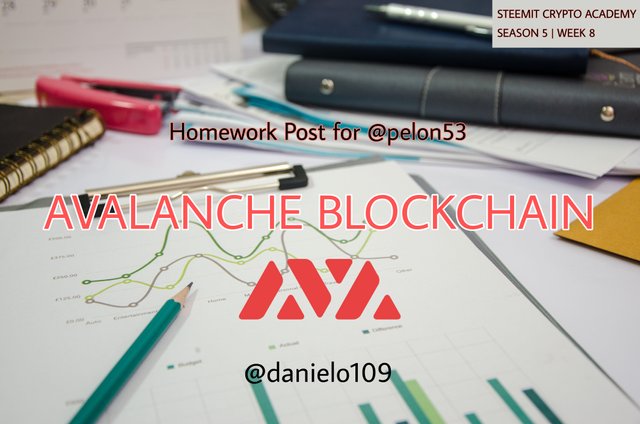
Hello everyone, this is my homework post for @pelon53 on Avalanche Blockchain. You can check out his lecture from here.
Avalanche Blockchain has seen a significant increase in value over the past few months. Its native token AVAX is currently in the top 20 cryptocurrencies. I wanted to do some research earlier, fortunately, Professor @pelon53 provided a lecture and assignment to educate us. Many thanks to him and all the Professors of the Steemit Crypto Academy. They've been of great help to members of the community. Before I commence with the homework task, let me talk a little about Avalanche Blockchain.
Avalanche Blockchain

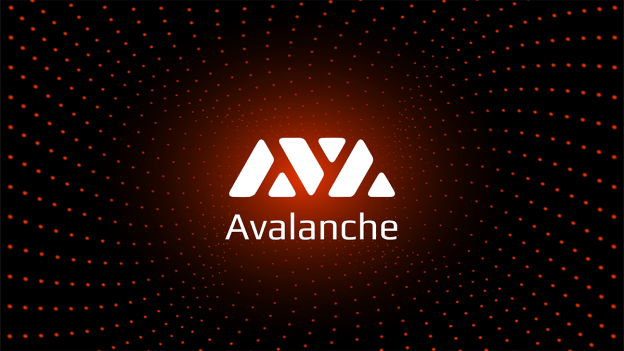
Avalanche Blockchain was built by Ava Labs. Ava Labs was created by a team of experts in computer science, finance, economics and law from Cornell University in the United States. The main figures of Ava Labs are Kevin Sekniqi, Daniel Laine, Stephen Buttolph, and Emin Gün Sirer.
Avalanche was launched in 2020 to provide users with a scalable, secure, customizable and high-performance Blockchain network. It is currently one of the top rivals of the Ethereum Blockchain. This is because of its low-cost charges and interoperability with the Ethereum Blockchain.
This platform was built for three major use cases.
- Building private or public application-specific blockchains.
- Building Decentralised Applications (Dapps) and
- Building Digital Assets.
Avalanche consists of many Subnets. A Subnet or a subnetwork consists of a set of validators. These validators work together to achieve consensus on the network. Avalanche allows the use of PoS and PoW consensus mechanisms on the subnets launched. It also uses its protocol Avalanche and Snow protocols for consensus on the network. I would explain the Consensus protocols later in this post.

1.- Explain X-Chain, C-Chain and P- chain in detail.
Avalanche Chains (X-Chain, C-Chain & P-Chain)

Avalanche consists of 3 blockchains. These are the Exchange Chain (X-Chain), Platform Chain (P-Chain), and Contract Chain (C-Chain). These chains are linked to the Primary Network and assume different functions. The Primary Network is responsible for securing the network and validation of the 3 blockchains. It is also a subnet and so it consists of a set of validators.
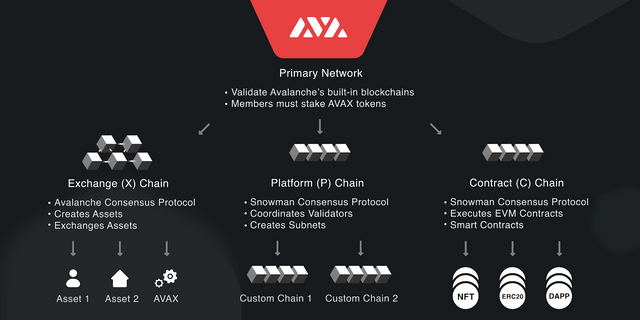
Exchange Chain (X-Chain)
The X-Chain provides a platform for exchanging and creating digital assets on Avalanche. It uses the Avalanche Consensus Protocol unlike the other blockchains on Avalanche which use the Snowman consensus protocol. $AVAX, the native token of Avalanche is located on this Blockchain along with other assets. For trading or exchange of assets, users are charged fees in $AVAX.
The assets creation procedure is quite simple on Avalanche. The technicalities are mostly handled by the developers and so the creators do less work. Asset creators need two requirements to proceed; familiarity with Avalanche architecture and completion of running a node on Avalanche. You can click here to check out the tutorial for creating an asset on Avalanche.
Platform Chain (P-Chain)
The P-Chain keeps track of active subnets and allows users to create subnets on Avalanche. Earlier I explained what a subnet was; a set of validators. Avalanche allows the creation of blockchains. These blockchains are validated by subnets. A subnet can validate many blockchains but every Blockchain has only one subnet responsible for validations. Users are also able to add validators to subnets through the P-Chain. Subnets can be built with rules or requirements for the management of acceptance and rejection of validators.
With this, the P-Chain manages the coordination of the Validators on the network. It also uses the Snowman Consensus Protocol.
Contract Chain (C-Chain)
The C-Chain is mainly for smart contracts. It uses the Snowman consensus protocol also unlike the X-Chain and also charges a fee of $AVAX for creating smart contracts.
This Blockchain allows users to create smart contracts compatible with the Ethereum Blockchain with EVM(Ethereum Virtual Machine). Users can create NFT, ERC-20 tokens and Dapps with the smart contracts on the C-Chain.

2.- Explore the Avax Network platform . Screenshots required.
Avax Network

To Explore the Avax Network Platform, visit https://www.avax.network/. You'd be taken to the homepage. I'm going to explore all the tabs on the platform below.
Homepage
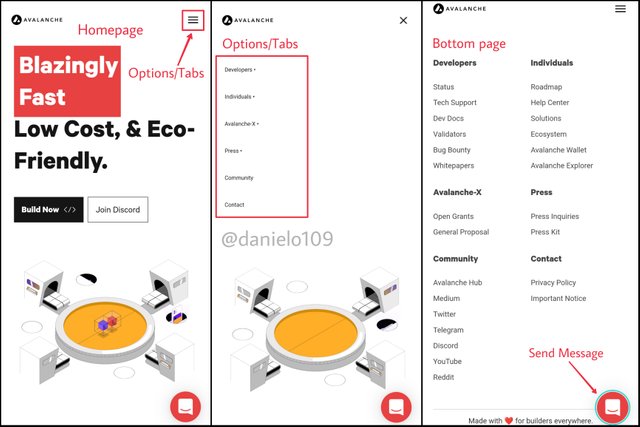
On the homepage, you can find general information about the Avalanche Blockchain. When you click on the Options, you'd be provided with tabs you can navigate to depending on what you're searching for on the Avax Network Platform. When you go down to the bottom of the page you can find quick links to the options for easy navigation. You can also send a message to the developers by clicking on the Send Message icon.
So there are 6 tabs you can navigate to. These are Developers, Individuals, Avalanche X, Press, Community and Contact. Some of these tabs have sub-sections. I'm going to explore all the tabs from the Developers down to the Contact tab.
Developers (Validators, Start Building)
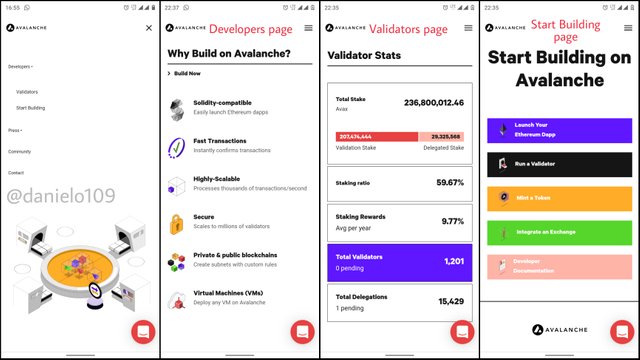
This tab is for users who are interested in becoming developers on Avalanche. You can get information on minting tokens, launching Dapps, validation etc. The subsections are Validators and Start Building.
Individuals (Roadmap, Solutions, Ecosystem, Avalanche Wallet, Avalanche Explorer, Avalanche Bridge)
The individuals has subsections like Roadmap, Solutions, Ecosystem, Avalanche Wallet, Avalanche Explorer and Avalanche Bridge.
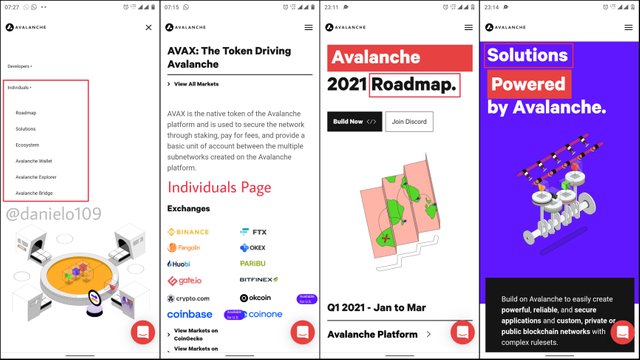
On the Individuals page, you can find information about the AVAX token. You can find information like the exchanges you can purchase AVAX and the supported wallets.
In the Roadmap subsection, you can find information about the improvements on Avalanche and their target.
Solutions provides users with use cases of Avalanche.
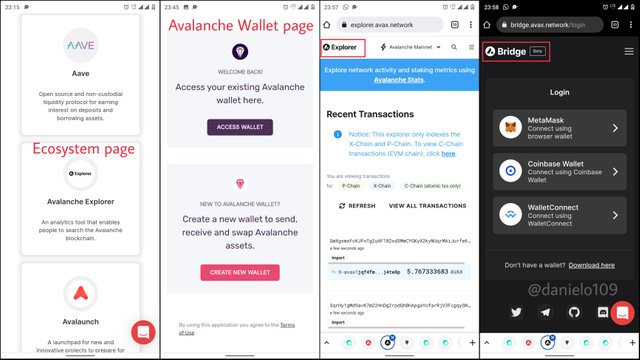
The Ecosystem section gives you information about the Dapps, exchanges, wallets etc that form part of the Avalanche Ecosystem.
The wallet section allows users to create an Avalanche Wallet and also manage their assets.
The Avalanche Explorer section allows users to track transactions on the P and X-Chain only. Users can view transactions from here.
The Avalanche Bridge page allows users to connect their wallets and wrap their tokens to be able to use them on Avalanche.
How to create an Avalanche Wallet
Creating an Avalanche Wallet is very simple and easy. You first have to go to the Avalanche Wallet page.
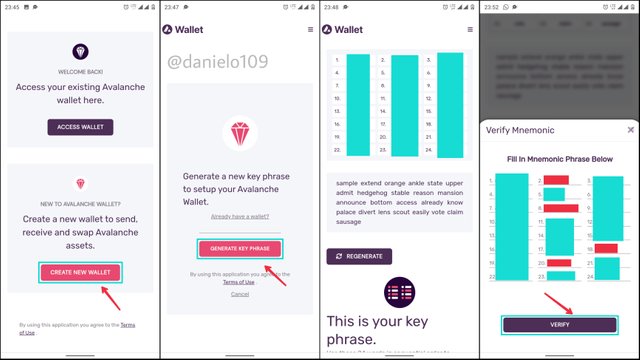
- Scroll down and click on Create New Wallet.
- Click on Generate Key Phrase.
- Copy your Key Phrase safely and proceed.
- You'd be required to input some missing words in your key phrase. Input the words and click on Verify.
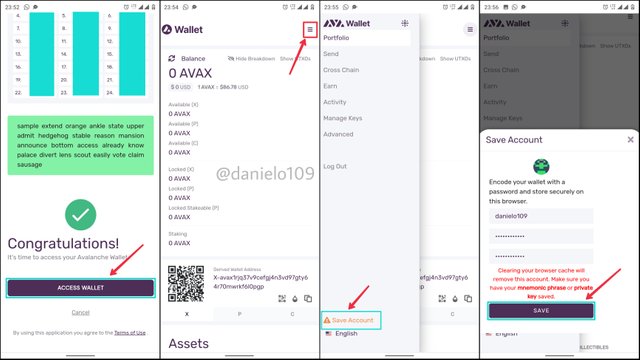
- You would receive a congratulatory message. Click on Access Wallet. Now, your wallet has been successfully created. You can choose to store your wallet on your browser by encoding it with a password. To do that, click on the options at the top right.
- Select Save Account.
- Enter the account name and password and click on SAVE.
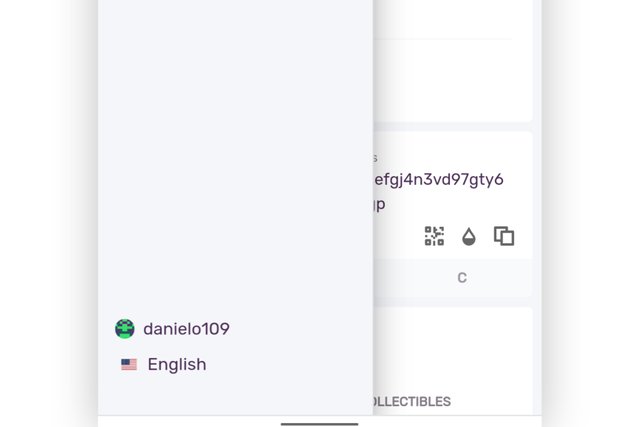
Your wallet would be saved successfully.
Avalanche X (Explore Open Grants, Submit a General Proposal)
This tab provides developers with support for building on Avalanche.
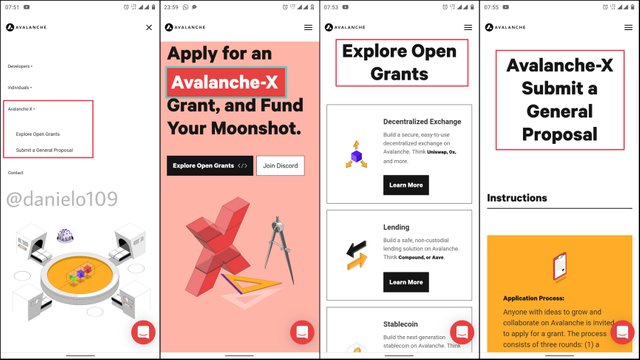
Explore Open Grants provides developers with ideas on what to build on Avalanche. This is very helpful when you don't know what to build.
The Submit a General Proposal section allows users to apply for funds to build their projects on Avalanche.
Press (Press Inquiries, Press Kit and Media Assets)
This section gives you information on News on Avalanche. You can locate the Avalanche Press Kit and Brand Assets subsection from here.
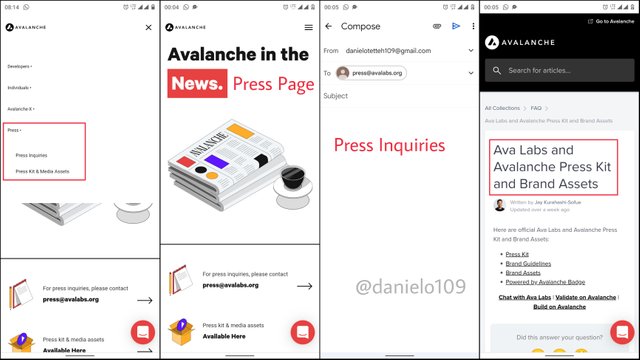
Press Inquiries allows you to send a mail to Avalanche.
Community
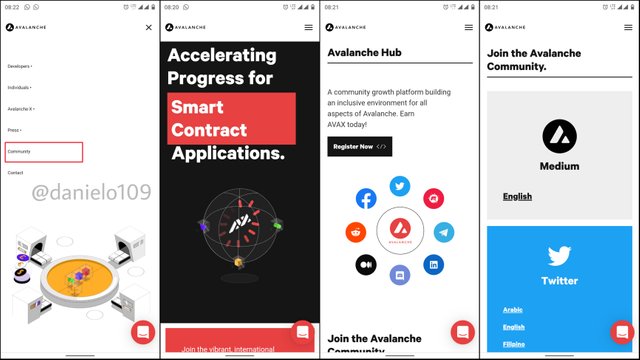
The community tab provides users with links to join other social media platforms like Twitter, Reddit, telegram and others for users to be able to socialize and get information.
Contact
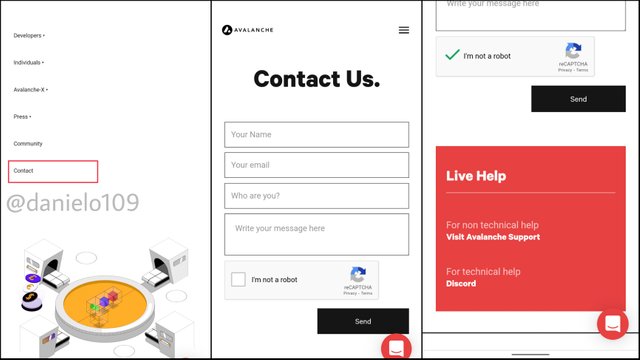
This is the last tab on the platform. This tab allows users to contact the developers for help and support.
3.- Show the last contract verified in the C-Chain network and show the Smart Contract that was generated at that address. Screenshots required.
Last Contract Verified in the C-Chain Network

To view the smart contracts and transactions on the C-Chain, visit https://snowtrace.io/.
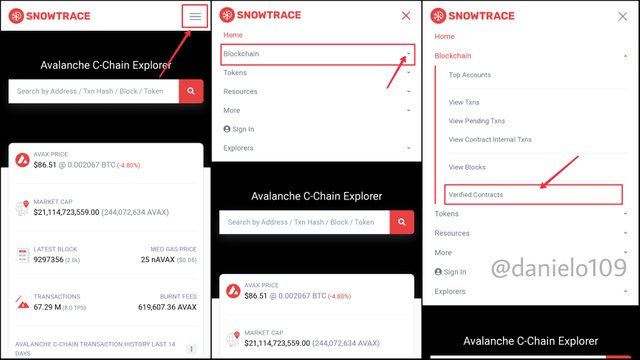
- Click on the options at the top right corner.
- Click on Blockchain.
- Select Verified Contracts.
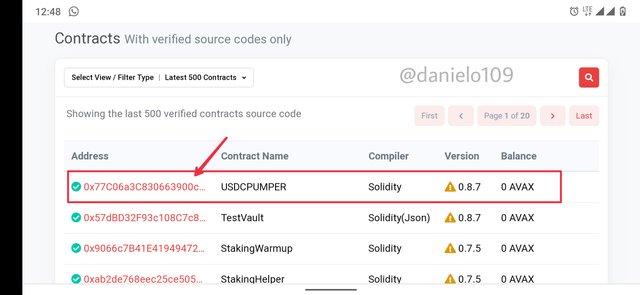
The last verified smart contract was USDCPUMPER. Its address is 0x77C06a3C830663900ca155838cEce9f4093ae884. I clicked on it to view the details.
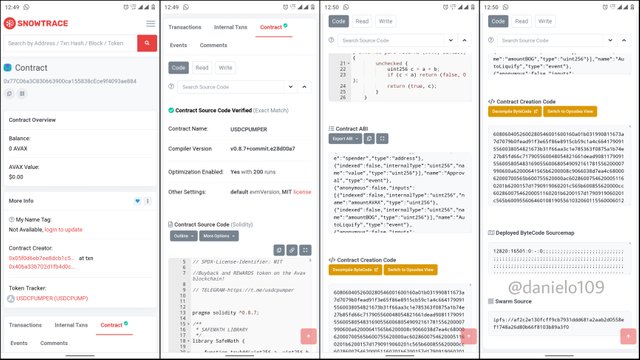
All the details of the Smart Contract can be found in the screenshots above.

4.- Explore the last block generated in the C-Chain network. Screenshots required.
Exploring the last block generated in the C-Chain Network

To explore the last block generated in the C-Chain, visit https://snowtrace.io/.
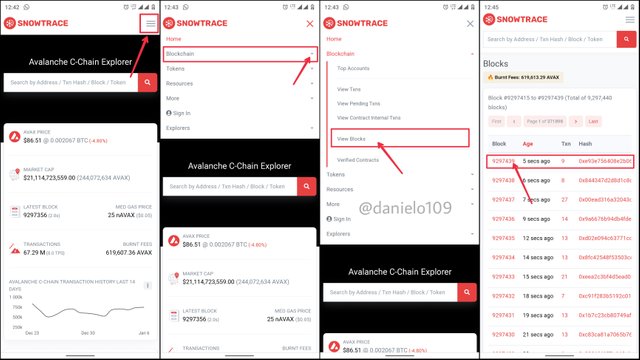
- Click on the Options at the top right corner.
- Click on Blockchain and select View Blocks.
The last block generated was #9297439. At the time the total number of blocks generated were 9297440.
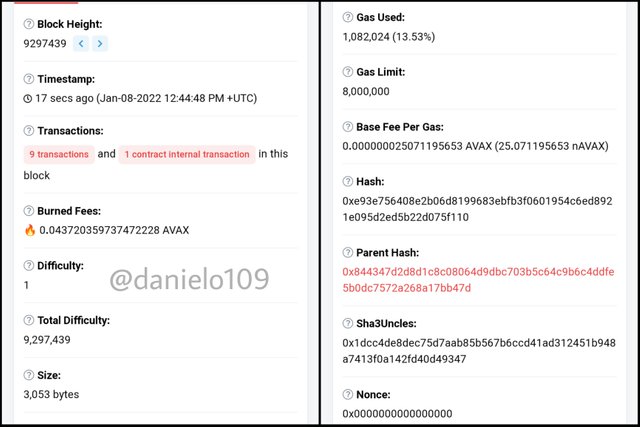
The timestamp is Jan-08-2022 12:44:48 PM +UTC. All the details of the block can be seen from the screenshot above. It's hash is 0xe93e756408e2b06d8199683ebfb3f0601954c6ed8921e095d2ed5b22d075f110 and the nonce is 0x0000000000000000.

5.- Explain in detail the Avalanche consensus protocol and the Snowman consensus protocol.
Avalanche Consensus Protocol

Avalanche Blockchain uses two consensus protocols on its Blockchain as mentioned earlier. The Avalanche Consensus Protocol and the Snowman Consensus Protocol. The Avalanche Consensus protocol is only used on the X-Chain while the Snowman is used on both the C and P-Chain.
Avalanche Consensus Protocol
According to the white paper, this protocol is inspired by the gossip protocol. It is efficient, scalable, fast, secure and fully decentralised. All the nodes are involved in the validation and processing of transactions and this is done in a parallel manner. This is because of the use of a data structure called Directed Acyclic Graphs (DAGs).
With Avalanche Consensus Protocol, no blocks are created when transactions are processed and validated. Rather, they appear as vertices.
Snowman Consensus Protocol
The Snowman Consensus Protocol is a build-up on the Avalanche Consensus Protocol. It provides two key guarantees; Safety and Liveness. This protocol creates blocks when transactions are processed and validated. Also, the nodes are in a linear manner, unlike the Avalanche Consensus Protocol.

Conclusion

Avalanche Blockchain is a Blockchain where developers interested in creating Ethereum compatible Dapps and Assets should consider. I personally think it was a smart idea by the developers to make it compatible with Ethereum and provide a more efficient platform with lower costs.
The splitting of the Blockchain into three is also a good way to reduce the workload and improve the speed of the Blockchain.
I've added it to my watchlist because I think it has high potential. Already making it to the top ten is good proof of its potential. I'm waiting to see how well it performs in the future.
Would like to thank @pelon53 for this lecture. I really learnt a lot.